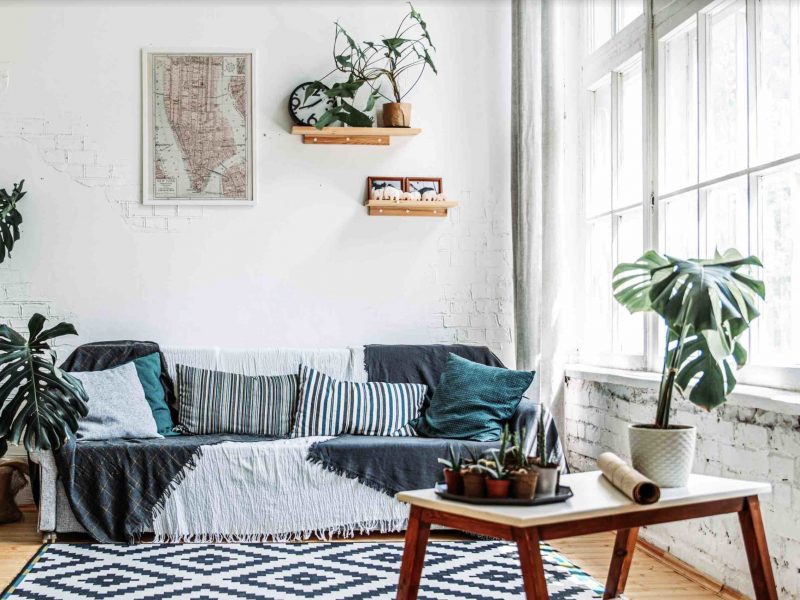
Houseplants that love east-facing windows
East-facing windows are some of the best for houseplants as they get plenty of sunlight, but it won’t be as intense as south-facing windows. This means the risk of leaf burn is significantly reduced and you can actually grow a lot more plants closer to the window. If you live in the northern hemisphere, your east-facing windows will let in a lovely amount of morning sunshine whilst the sun isn’t yet at its strongest as well as plenty of indirect light throughout the afternoon and evening.
You will find that a lot of tropical plants that grow well in the forest canopy love the amount of light given by east-facing windows so you have plenty of choice when it comes to incredible foilage.
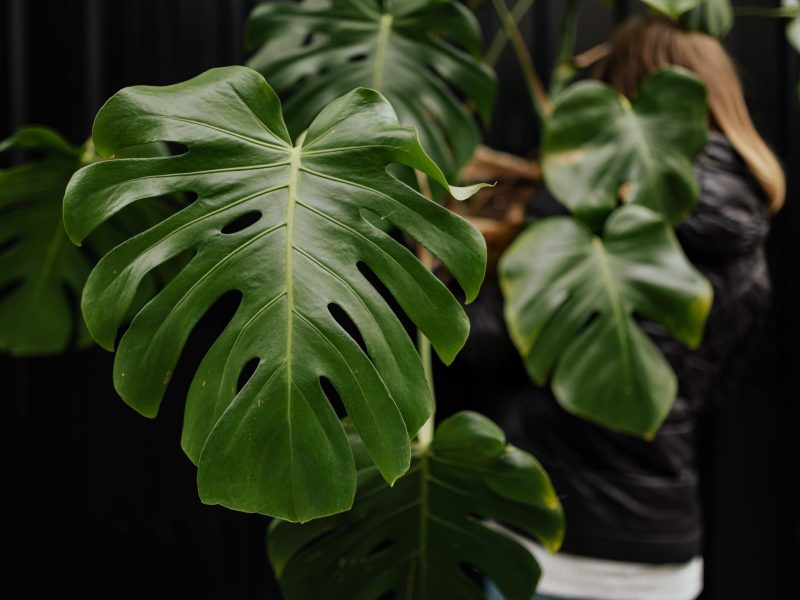
Swiss Cheese Plant
Monstera deliciosa
Native to the rainforests of Central America, the Monstera Deliciosa has very quickly become the most fashionable and photographed houseplant ever. And it’s not difficult to understand why… If their large dark green glossy heart-shaped leaves weren’t enough, their unique splits surely will be!
You might be surprised to learn that the Monstera isn’t actually a fussy plant and is pretty easy to take care of. Bright but indirect light, moderate amounts of water and regularly misting are really the main things to remember. They’ll love the sunshine that pours through the east-facing window in the morning!
You’ll find that a lot of more mature Monstera plants are sold with a moss pole as they are climbing plants. In the rainforest, the ariel roots that pop out from the stems will attach themselves to other plants as the plant matures. So a moss pole is a good substitution to help your plant grow and mature.
Find out more in our Swiss Cheese Plant care guide.
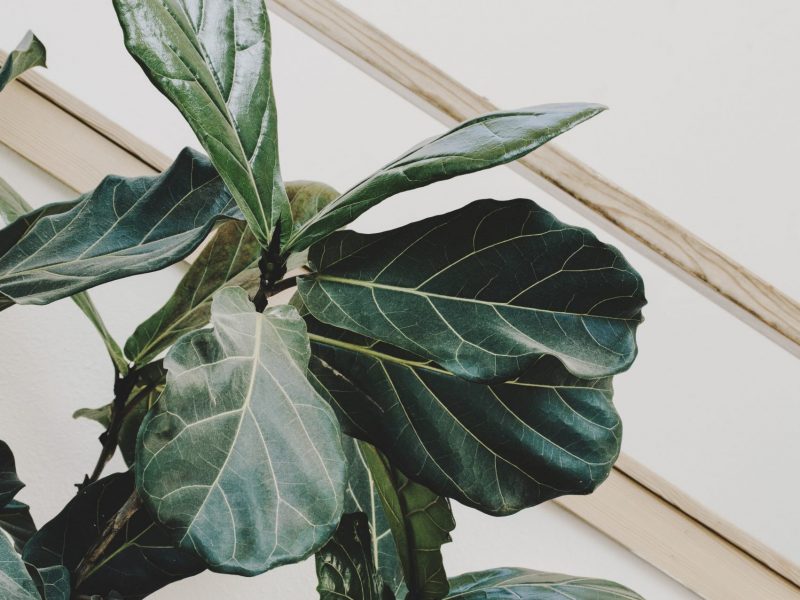
Fiddle Leaf Fig
Ficus lyrata
Native to the rainforests of central Africa, Fiddle Leaf Fig Trees are really stealing all of the attention right now. Their giant dark green glossy veined leaves give you that instant tropical feeling, right in your own home. They actually get their name from their violin-shaped leaves, similar to a Fiddle. Fiddle Leaf Fig Trees like a nice warm, humid environment with plenty of sunshine and a good amount of water to support a strong root system. We recommend placing your Fiddle Leaf Fig pretty close to your east-facing window to maximise that morning sunshine.
If you’re looking for your plant to become the focal point of the room, then the Fiddle is the plant for you as they can grow up to 3 metres tall in the right environment. It’s important to note though that Fiddle Leaf Figs are toxic to pets and humans so not the best chance if there is a risk of leaves being ingested…
You should be able to find a Fiddle Leaf at most independent plant shops globally, but they can have quite a big price tag if you’re looking for a more mature one.
Find out more in our Fiddle Leaf Fig care guide.

Alocasia Dragon Scale
Alocasia baginda
Although once a very rare houseplant, you’ll now find these popping up a little more and we are obsessed with their giant textured and deep veined leaves. The patterned leaves look like dragon scales which explains the name! The leaves are tough and have a hard top which is quite unique for indoor plants.
Native to the tropical forests of Borneo, this houseplant looks daunting to care for but it’s actually pretty simple. Avoid putting them on super bright windowsills as this can damage the leaves (which is why they are perfect of east-facing windows) and a boost to the humidity will go a long way. Out of all the Alocasia varieties, this is definitely one of the least fussy plants so even less experienced plant parents can enjoy these fairytale leaves.
Find out more in our Alocasia Dragon Scale care guide.
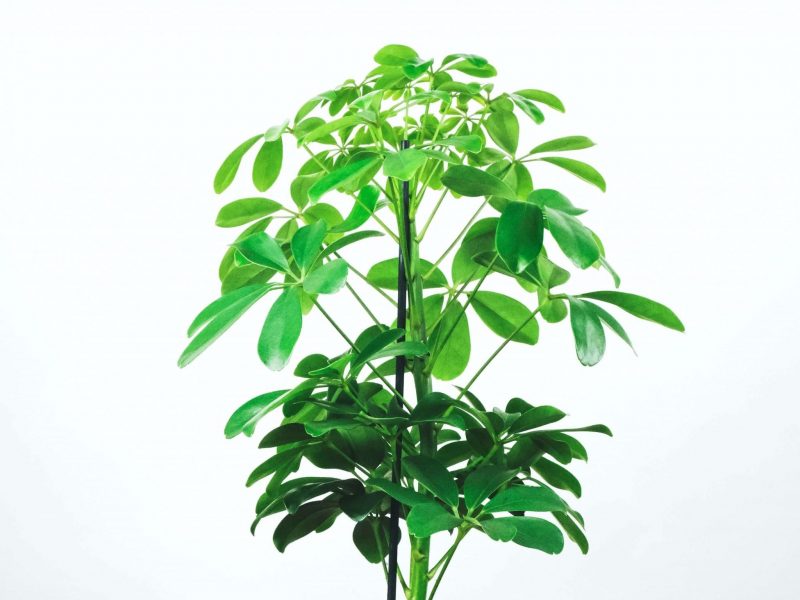
Schefflera
Schefflera arboricola
Also known as the Umbrella Plant because of their dome-shaped leaves, the Schefflera is not only easy to care for but it’s pretty unique too! A mature Schefflera can sometimes have up to 16 little leaves off one stalk, whilst smaller plants may only have 4 or 5.
When it comes to caring for your Schefflera, they are quite hardy and adapt well to different environments. You don’t need to worry about humidity levels etc so it’s pretty simple. One thing to note is that it’s a good idea to rotate your plant every few weeks. Schefflera plants have a tendency to lean towards the light so can become quite unbalance if not turned regularly.
Unfortunately, Scheffleras are toxic to pets and humans so you need to keep this one away from small children or any furry friends that might be tempted to take a bite.
Find out more in our Schefflera care guide.
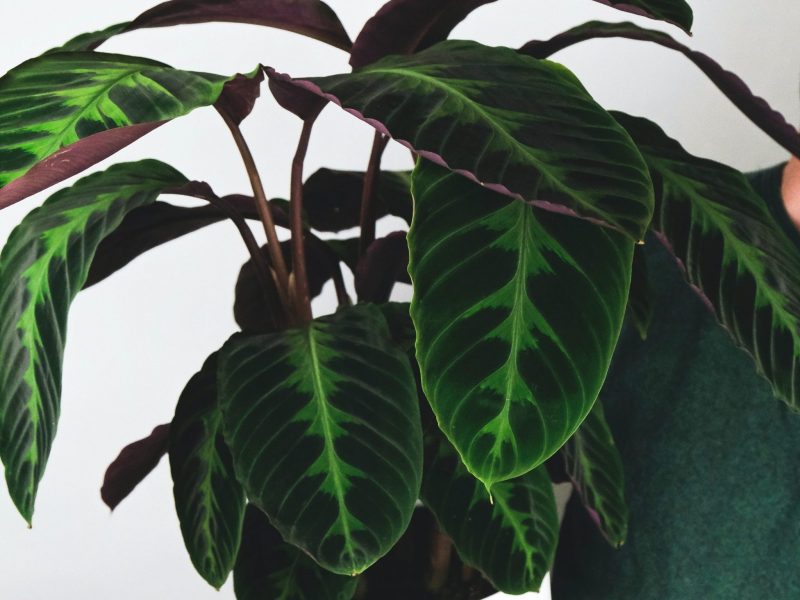
Calathea Jungle Velvet
Calathea warscewiczii
Part of the Prayer Plant family, the Jungle Velvet Calathea will really bring something special to your home! They have long elegant two-tone dark green leaves with gorgeous purple undersides. The Jungle Velvet Calathea gets its name from the soft and velvety texture of their leaves which is something very unique to this variety.
Native to Costa Rica, it can be a little tricky to replicate the native environment in your home but warm temperatures and a boost to the humidity will go a long way! And if you needed more reasons to love this plant, they are air-purifying and pet-friendly too so are great to have around the home.
Find out more in our Calathea Jungle Velvet care guide.
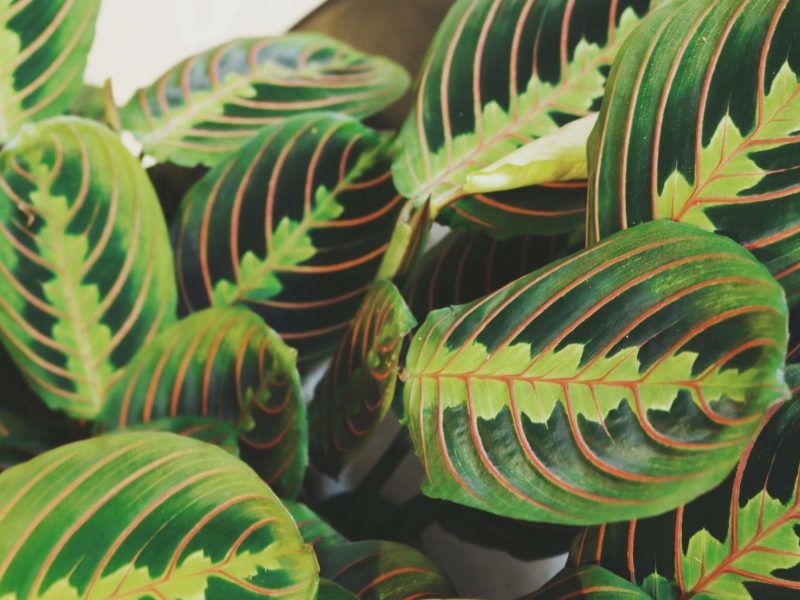
Prayer Plant
Maranta leuconeura
Native to the tropical rainforests of Brazil, the Prayer Plant is loved for its variegated leaves with intricate vein patterns. You can easily spot a Prayer Plant by its leaf undersides as shades of deep red are revealed when the plant’s leaves curl up at night, bringing a splash of colour to your home.
There are several varieties of Prayer Plants that all look ever so slightly different. The most common is the tri-colour which has red-veined leaves but you’ll sometimes see varieties with silver patches or dark green splashes. Prayer Plants are a little fussy though with light conditions, soil moisture and humidity levels though so we don’t recommend this as a starter plant, unfortunately.
Find out more in our Prayer Plant care guide.
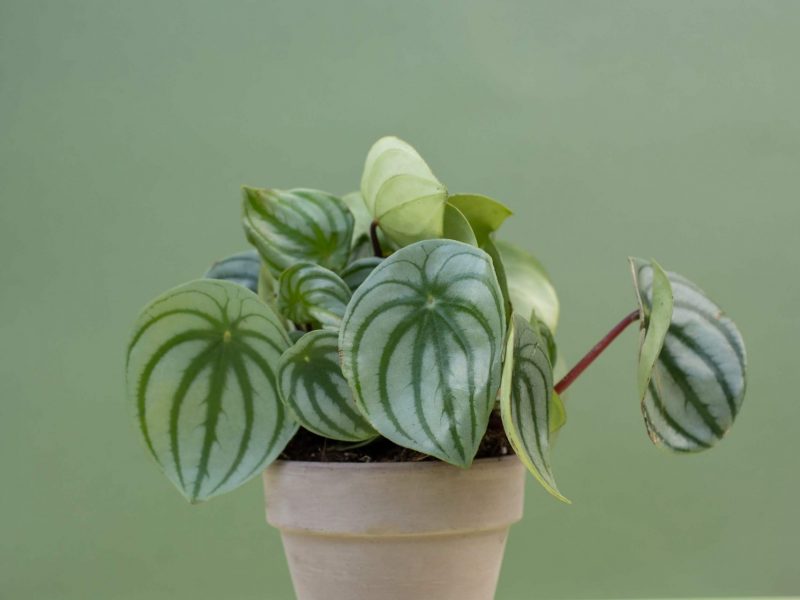
Watermelon Peperomia
Peperomia argyreia
There aren’t really many leaves that are more beautiful and striking than those of the Watermelon Peperomia. It’s not difficult to know where they got their name from, as their silvery stripes steal the hearts of plant parents everywhere.
They are quite a delicate plant though, as their large heavy leaves are held up by relatively weak stems so be prepared to lose a few leaves here and there. Another thing to be prepared for when owning this plant is all of your friends wanting a cutting, but luckily this plant is super easy to propagate so no problems there!
Native to South Africa, the Watermelon Peperomia prefers mid-light levels, as they are used to the dappled conditions of the jungle floor which makes them perfect for east-facing windows. Oh, and as they are a semi-succulent, it’s important you don’t water this one too much or the stems can give up and the whole plant will droop and wilt.
Find out more in our Watermelon Peperomia care guide.

Calathea Medallion
Calathea veitchiana
The Calathea Medallion is one of our favourite Calathea varieties due to their large patterned striking leaves with deep purple undersides. Native to the tropics of South America, the Calathea Medallion loves warm temperatures and a high humidity level so misting the leaves is crucial.
The indirect light that comes through east-facing windows is perfect for this Calathea as harsh intense sunlight will fade and scorch the leaves, causing them to lose their incredible markings.
As with all Calatheas, the Medallion variety is also air-purifying and non-toxic to both humans and pets!
Find out more in our Calathea Medallion care guide.
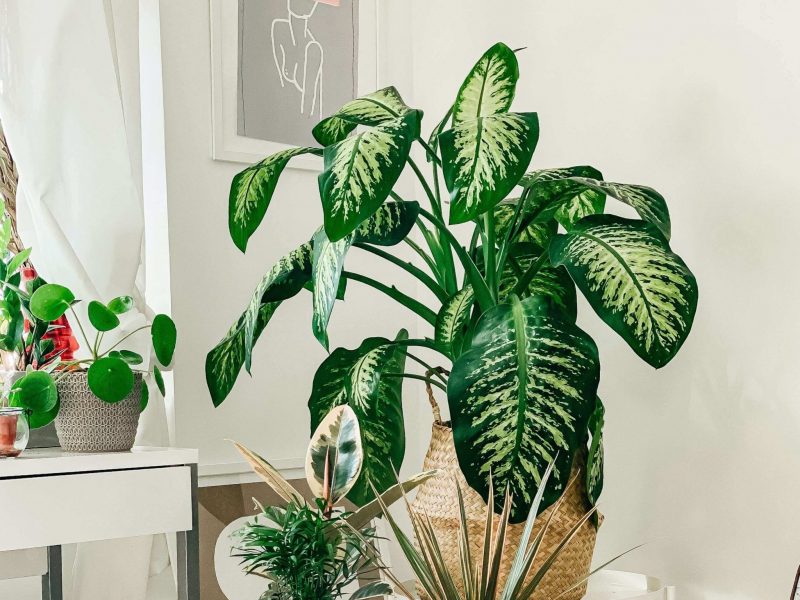
Dumb Cane
Dieffenbachia
With incredible large speckles leaves, the Dumb Cane really does know how to impress! It has got a little bit of a bad reputation, however, as it’s very toxic to both humans and pets and can cause temporary loss of speech if consumed in large quantities (hence the name). However, this is quite rare and whilst important to keep in mind, shouldn’t put you off this plant entirely.
Dumb Cane plants are pretty forgiving and bounce back pretty quickly, so you don’t need to worry about occasionally over or underwatering. Just provide them with plenty of indirect sunshine and the occasional misting and they’ll reward you with some of the most beautiful foliage.
Find out more in our Dumb Cane care guide.
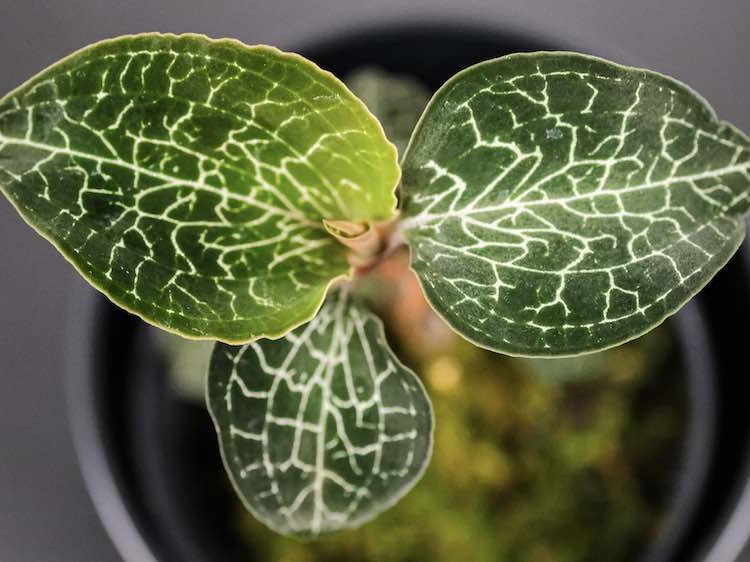
Jewel Orchid
Ludisia discolor
Jewel Orchids are fast becoming one of the most popular houseplants due to their lightning bolt veined leaves! They aren’t always the easiest plant to take care of, but with leaves like that, it’s worth all the hassle.
Native to the rainforests of Southeast Asia, high temperatures and a good humidity level will help your Jewel Orchid thrive! You’ll want to place them somewhere with medium light levels as too much light will scorch the leaves, and shady corners will lead to a lack of growth! This makes them the IDEAL east-facing window plant!
Jewel Orchids do grow slowly though so appreciate the plant that you have and appreciate the fact it won’t outgrow the pot or your home anytime soon.
Find out more in our Jewel Orchid care guide.
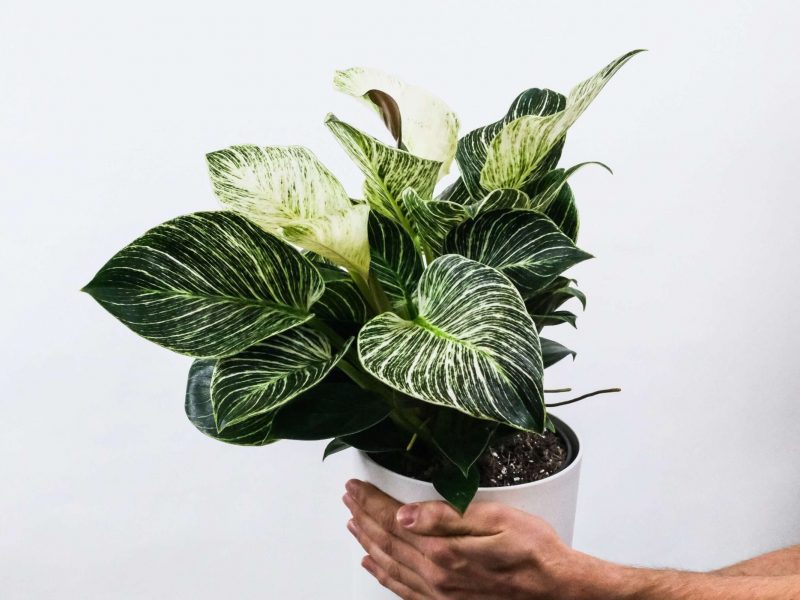
Philodendron Birkin
Philodendron Birkin
This used to be an extremely rare and unknown plant but over the past few years, it’s definitely gained a place in the houseplant walk of fame! Unlike a lot of its Philodendron relatives, the Birkin is a non-vining plant that stays pretty compact, making it great for windowsills and smaller spaces.
Loved for their green and cream striped leaves, the Philodendron Birkin needs a humid environment to really thrive. This is because they are native to the rainforests of Brazil so be prepared for regularly misting (or just buy a humidifier), as otherwise, you’ll see brown leaves appear pretty quickly. With the right care and environment, the Birkin can be a pretty quick grower so it’s definitely worth a little bit of extra hassle.
Find out more in our Philodendron Birkin care guide.
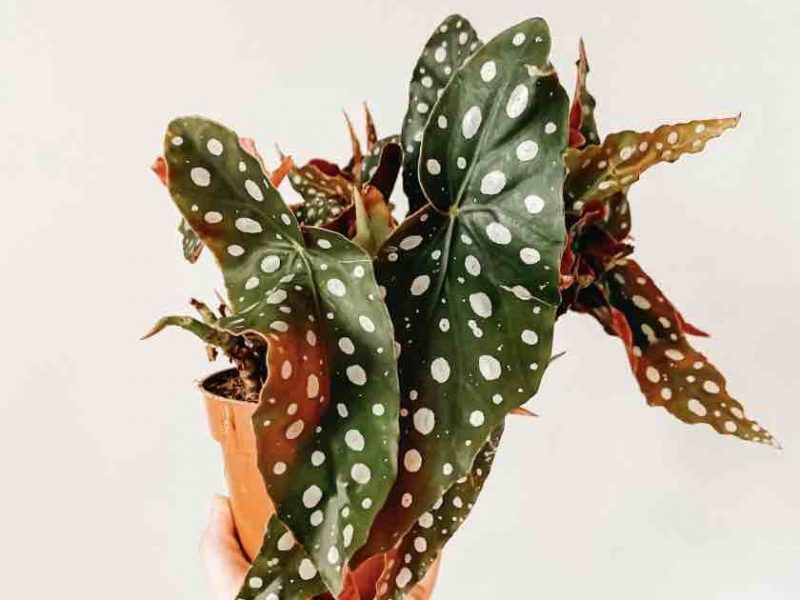
Polka Dot Begonia
Begonia maculata
With their unique angel-shaped dotted leaves, the Polka Dot Begonia is a fairly easy plant to care for once you know what to do with them. Bright, indirect light and consistent watering (making sure not to let it dry out) will keep your Polka Dot Begonia happy. When all of their needs are met, they can grow quite quickly and will likely need repotting every year.
It’s worth noting that they do like slightly higher humidity levels, but this shouldn’t be maintained by misting as water collecting on the leaves can cause damage. Instead, we’d recommend placing them somewhere naturally humid or using a humidifier/pebble tray to supplement.
Find out more in our Polka Dot Begonia care guide.














